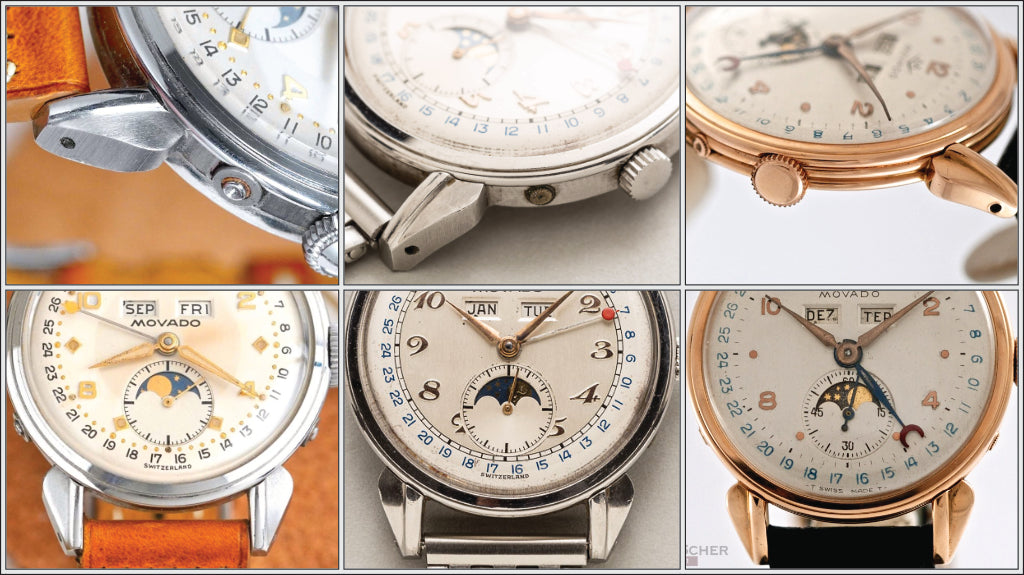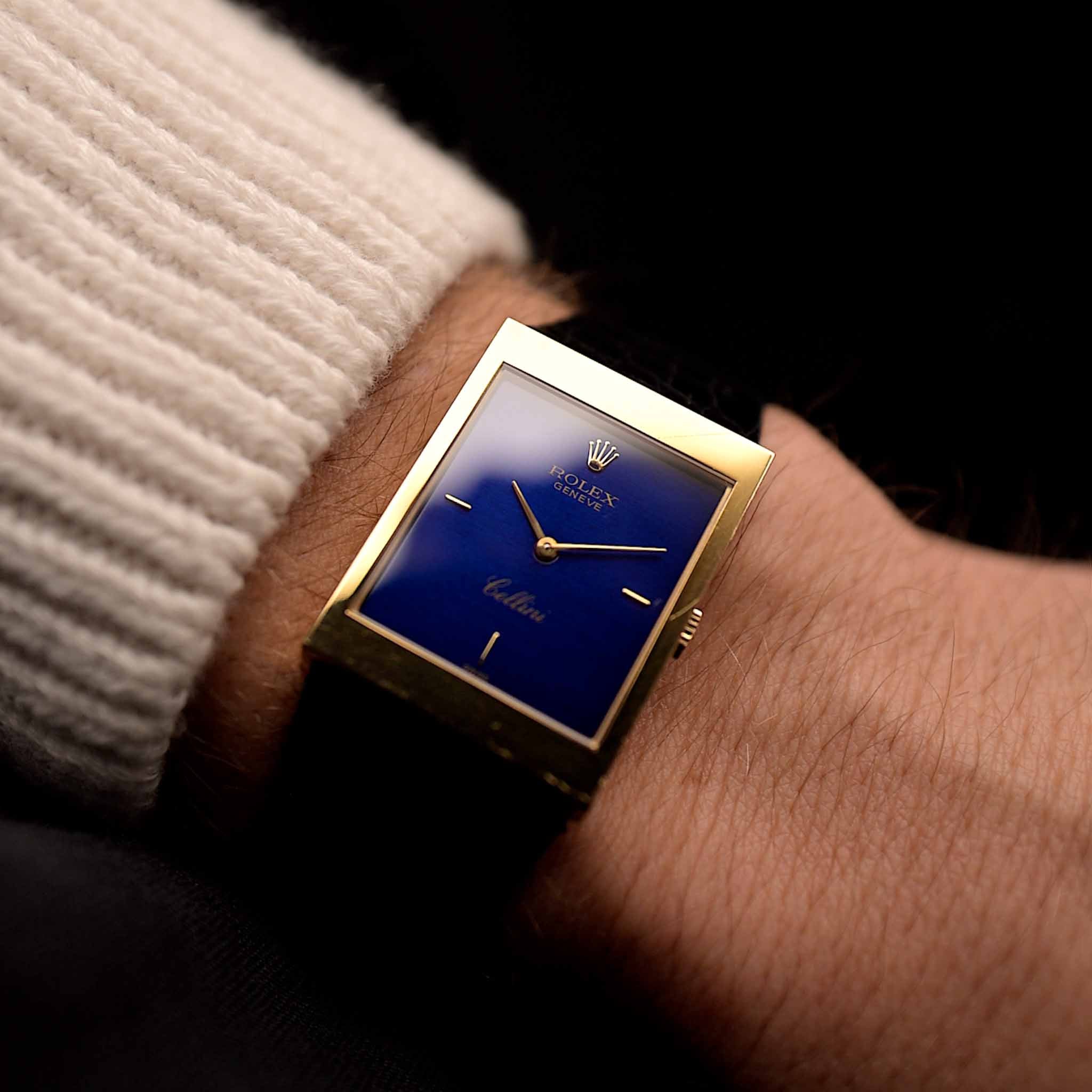The Bumper movement is foremost a real haptic experience! If you ever get the chance take that "hammer" automatic to your wrist and make the weight "bump" into the case. It's such a visceral experience, never again will you feel the same feedback from your watch... But what's the history behind these pieces and what place does this - now considered - peculiarity hold in watchmaking history?
October 11, 2023
Watch Movement Evolution - The Bumper Automatic

Marcus Siems @siemswatches
Collector, Author, Data Analyst
I very much enjoy manually winding my watches in the morning. The haptic interaction with time is a much anticipated routine... it's probably about the melody of clicking gear trains. In my opinion this intimate conversation with a not-at-all lifeless objects can only be topped by the ongoing chatter you'll experience when putting a watch with bumper-style movement to your wrist. The visceral feedback from rolling over your wrist and perceiving how your watch gains energy and awakes with you is unparalleled. However, only very few people can even relate to what I'm speaking about ... and that's simply because modern automatic watches don't "bump" anymore.
So what's a bumper then and how did automatic watches look back then? We can trace the evolution of the automatic watch all the way to the 1770s to the invention of Abraham-Louis Perrelet, and improvements to the concept by Abraham-Louis Breguet[1]. But those were pocket watches and it was a trend that didn't last. So the idea of an automatic winding mechanism was pretty much forgotten until the early 20th Century.
Three Automatic vintage watches, three different winding mechanisms... An overview of the Full-Rotor (Rolex), Bumper (UG Polerouter steel) & Micro-Rotor (UG Polerouter rose gold).
1) The First Bumper Automatic Wristwatches
In 1924 John Harwood revived the idea of a "self-winding" watch, and this time it's been wrist-worn[1-3]. And the system he used? The so-called bumper-style (or hammer automatic) movement. Hereby, a large weight in the shape of a hammer was attached centrally at the movement and could freely rotate around an arc of about 200-270 degrees. Spring bumpers were connected to both ends of the hammer to bounce it off and effectively use as much energy as possible. This system made it possible to transfer the kinetic energy of the arm's motion into the mainspring. It thus works a bit like a seesaw. That's a view you won't get through a modern open caseback.
 Visualizing the winding weight on a 1950s Omega Constellation with Cal. 354 bumper movement. The winding weight "hammer" (in light blue) can rotate freely in an arc of about 270 degrees (indicated in pink). The motion energy is transferred through the ratchet wheel into the mainspring and can thus power the watch. Photo Goldammer Archives.
Visualizing the winding weight on a 1950s Omega Constellation with Cal. 354 bumper movement. The winding weight "hammer" (in light blue) can rotate freely in an arc of about 270 degrees (indicated in pink). The motion energy is transferred through the ratchet wheel into the mainspring and can thus power the watch. Photo Goldammer Archives.
Harwood's winding system was soon eclipsed by Rolex's infamous 360 degree full-rotational system in 1931 with the caliber 620[2]. The full-rotor system was superior to the bumper-style - a full oscillation is more energy efficient than bumping back and forth. However, that didn't stop the development of the bumper. Well, that's not exactly true... due to Rolex's tight-knit patent the bumper still had to be applied by non-Wilsdorf brands for the next 20 years*! So most brands were stuck with one version or another of the Harwood system.
2) Who made the Bumper Famous?
Spearheading the development of the bumper winding system were probably Omega, Jaeger-LeCoultre and Universal Geneve. They weren't the only manufacturers developing this movement further but likely the best known examples today.
Omega. Omega introduced their first (mass produced) automatic movement with bumper winding system, the Caliber 28.10RA PC in 1943[4-5]. This movement was later renamed into the Cal. 3XX series in 1949 and powered for example the earliest Constellation models[6].
 Omega really used the bumper movement all through the board. Here's a great example of an automatic Seamaster with the iconoclastic beefy lugs from the early 1950s. Photo Goldammer Archives.
Omega really used the bumper movement all through the board. Here's a great example of an automatic Seamaster with the iconoclastic beefy lugs from the early 1950s. Photo Goldammer Archives.
Jaeger-LeCoultre. The watchmakers watchmaker entered the automatic movement market in 1946 with their Caliber 476[7-8] and redesigned the concept in 1948 with the introduction of the Cal. 481 with Power Reserve indication[9]. Alongside assembling their own pieces JLC also provided their bumper movements to for example Vacheron Constantin (K477 from 1951)[1,10].
Universal Geneve. One of the most iconic pieces from that era, Universal Geneve's Polerouter, was originally introduced featuring the half-oscillating movement weight with the Martel Caliber 138 from 1948[11].
 Another brand that expedited the development of the bumper automatic was Jaeger-LeCoultre. Beside their Power-Reserve indicator (cal. 481) they also introduced the very first automatic alarm watch in 1956 (cal. 815). Photo Goldammer Archives.
Another brand that expedited the development of the bumper automatic was Jaeger-LeCoultre. Beside their Power-Reserve indicator (cal. 481) they also introduced the very first automatic alarm watch in 1956 (cal. 815). Photo Goldammer Archives.
3) The Bumper Movement in Numbers
So we think the full-rotor movement must have been an instant success... particularly because Rolex's marketing department has always been great in branding innovation. But how common have these different automatic movement types really been? Interestingly, almost all of Bumper movement manufacturers sold them alongside full-rotor automatic pieces even after the patent limitation was lifted. Thus, the full rotor has not been the absolute favorite for everyone, at least for a certain transition period until the late 1950s.
It's of course very hard to tell how popular these different movement styles truly were. And we don't know for sure but a good first guess can come from comparing listings on Chrono24**[12]. We can find a total of just over 2,200 automatic timepieces from the 1930s, 40s, and 50s. Of which there are 770 Rolex (35% & 2% Tudor), ~650 Omega (29%), ~70 Jaeger-LeCoultre (3%), ~70 Longines* (3%), ~45 Universal Geneve (2%) and ~40 Zenith (2%) watches.
 Figure 1. Approximate distribution of different automatic watch movements by brand between 1930-1960[12]. Dashed and solid lines indicate predominantly full-rotor and bumper-style movements, respectively.
Figure 1. Approximate distribution of different automatic watch movements by brand between 1930-1960[12]. Dashed and solid lines indicate predominantly full-rotor and bumper-style movements, respectively.
Indeed, we see that with the arrival of different competitors on the market Rolex's share in the realm of automatic watches decreases. From what we can deduce here Rolex watches are by far the most common pieces you can come across these days when you look into the late 1930s and early 1940s (peak at 61% in 1941).
But Omega really made a big splash with their bumper upon introduction. Between 1945 and 1955 both brands are pretty much on par regarding automatic watch popularity. Even taking all the different caveats and biases of this data into account it is probably still safe to say that Rolex didn't blow away their competition. At least Omega's bumper automatic pieces have been as if not more popular than Rolex's Perpetuals.
 Omega truly has been a rightful contender for one of the most influential automatic movements of the last Century. Their 28.10RA PC was among the most sought movements of its time - overall, we're looking at a production volume likely north of 1.3mio. produced pieces[4]. Photo Goldammer Archives.
Omega truly has been a rightful contender for one of the most influential automatic movements of the last Century. Their 28.10RA PC was among the most sought movements of its time - overall, we're looking at a production volume likely north of 1.3mio. produced pieces[4]. Photo Goldammer Archives.
4) Conclusion
From today's perspective the bumper-style movement is an oddity and something you won't really come across if you are not into vintage. We are all way more accustomed to the full-rotor concept and already a peripheral Microtor pops out like an NBA player among jockeys. However, the bumper movement has its rightful place in the annals of watchmaking history.
 The full triad*** of automatic wristwatch winding mechanisms - the Full-Rotor (left, Rolex), the Bumper (middle, UG) & the Micro-Rotor (right, UG). Photo Goldammer Archives.
The full triad*** of automatic wristwatch winding mechanisms - the Full-Rotor (left, Rolex), the Bumper (middle, UG) & the Micro-Rotor (right, UG). Photo Goldammer Archives.
First, it was the original concept of wrist-worn automatic watches. Second, it became extremely popular due to Rolex's 20 year patent on the superior full-rotor winding mechanism. Third, because it seems that customers still valued the bumper technology highly - at least until the late 1950s and early 1960s - even when they had the choice. And finally, it's a real wrist experience! If you ever get the chance take that "hammer" automatic to your wrist and make the weight "bump" into the case. It's such a haptic experience, never again will you feel the same feedback from your watch.
* That is every brand except Longines (and maybe some others?)... The Saint-Imier manufacturer may have found a loop-hole in the patent or collaborated with Rolex on their full-rotor cal. 22AS launched already in 1945[13-14]. However, it is a mystery to me how Longines made this happen.
** Using data from a rather unconstrained public database is of course a critical endeavor that holds several limitations. No one can guarantee that all information provided are accurate. I rely on the law of big numbers here and argue that some uncertainties from single watches average out. Further, single brand biases will be rather stable over different vintages and trends over time might be more reliable than single gross comparisons between brands. But as with every piece of data be aware of the shortcomings.
*** There exist at least a fourth winding mechanism: The Peripheral Rotor. Hereby, the weight oscillates freely around the movement periphery without central fixation. Thus, the stem and crown had to be moved to the back of the watch. Patek Philippe for example patented the cal. 350 (1965) and used it sparsely (ref. 3569 is one example).
References
[1] How Watches Work: What is an Automatic Watch; Brandon Baines, Fratello;
[2] A Brief History of Time: Rolex Part I (1905-1945); Brandon Baines, Fratello;
https://www.fratellowatches.com/rolex-brand-history-part-one-1905-1945/
[3] Jaeger-LeCoultre, Automatic Movements & the Power-Reserve; Marcus Siems, Goldammer Vintage Watches;
https://goldammer.me/blogs/articles/jaeger-lecoultre-powermatic
[4] Watch Movements: Omega 28.10RA PC; ranfft;
http://www.ranfft.de/cgi-bin/bidfun-db;Omega_28_10RA_PC
[5] Omega Watches and Their Movements; ChronoMaddox;
https://www.chronomaddox.com/OmegaCaliberList.html
[6] Omega Constellation Reference Guide - The Pie-Pan Era; Marcus Siems, Goldammer Vintage Watches;
https://goldammer.me/blogs/articles/omega-constellation-guide-pie-pan
[7] An interesting page of JLC History: Automatic watches; Nicolas amanico, WatchProSite;
[8] JLC 476; WatchWiki;
https://www.watch-wiki.net/doku.php?id=jlc_476
[9] JLC 481; WatchWiki;
https://www.watch-wiki.net/doku.php?id=jlc_481
[10] Collector Guide Vacheron Constantin Time-Only Movements; Allen Farmelo, Beyond The Dial;
[11] Universal Geneve - History; Universal Geneve Info
https://universalgeneve.info/content/6-history
[12] Chrono24 - Listings of Automatic watches (filter 1930-1959), extracted Oct. 09 2023; Karlsruhe, Germany;
https://www.chrono24.com/search/
[13] Watch Movements: Longines 22AS; ranfft;
http://www.ranfft.de/cgi-bin/bidfun-db;Longines_22AS
[14] Tracing the horological heritage of Longines; Nico Bandl, SwissWatches Magazine;
https://swisswatches-magazine.com/blog/longines-1832-history/
All rights on text and graphics reserved to the Author.




























1 comment
Really enjoyed it and learned a lot. Thank you
Leave a comment